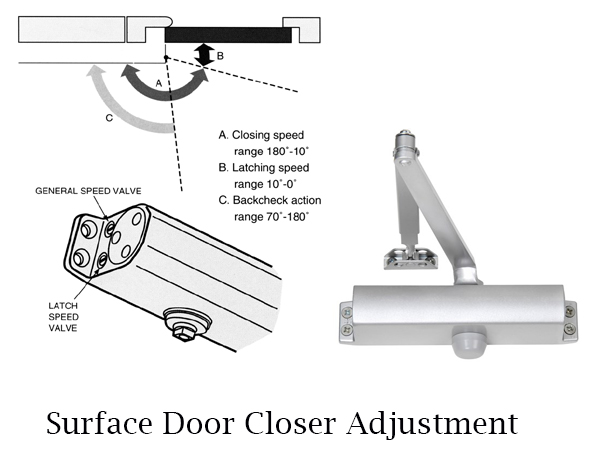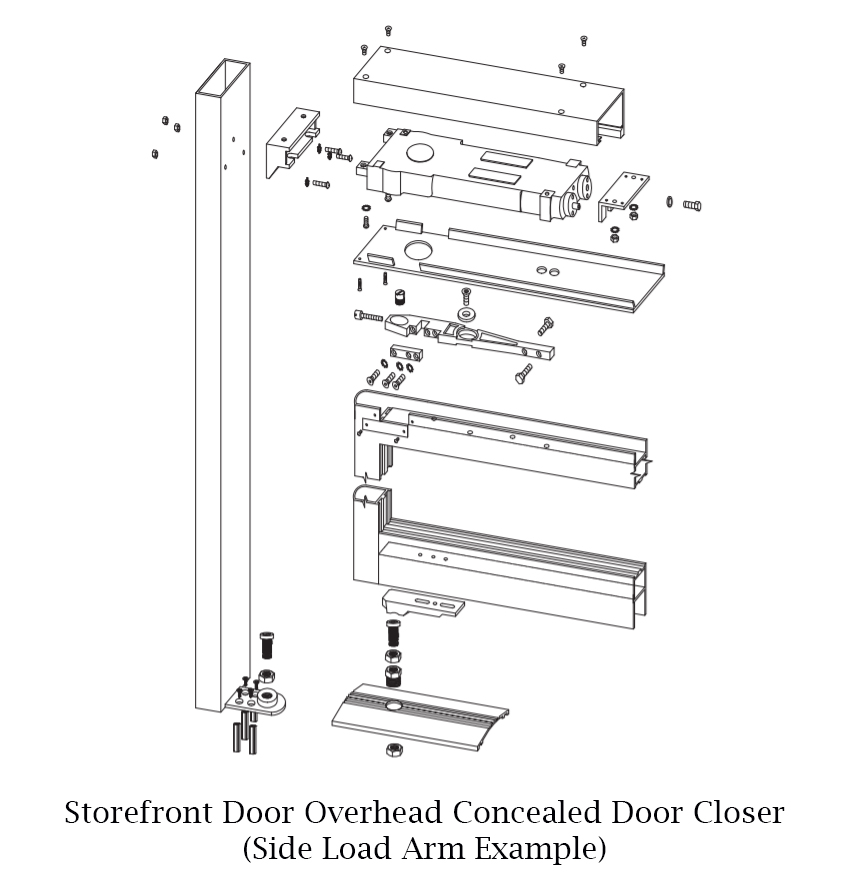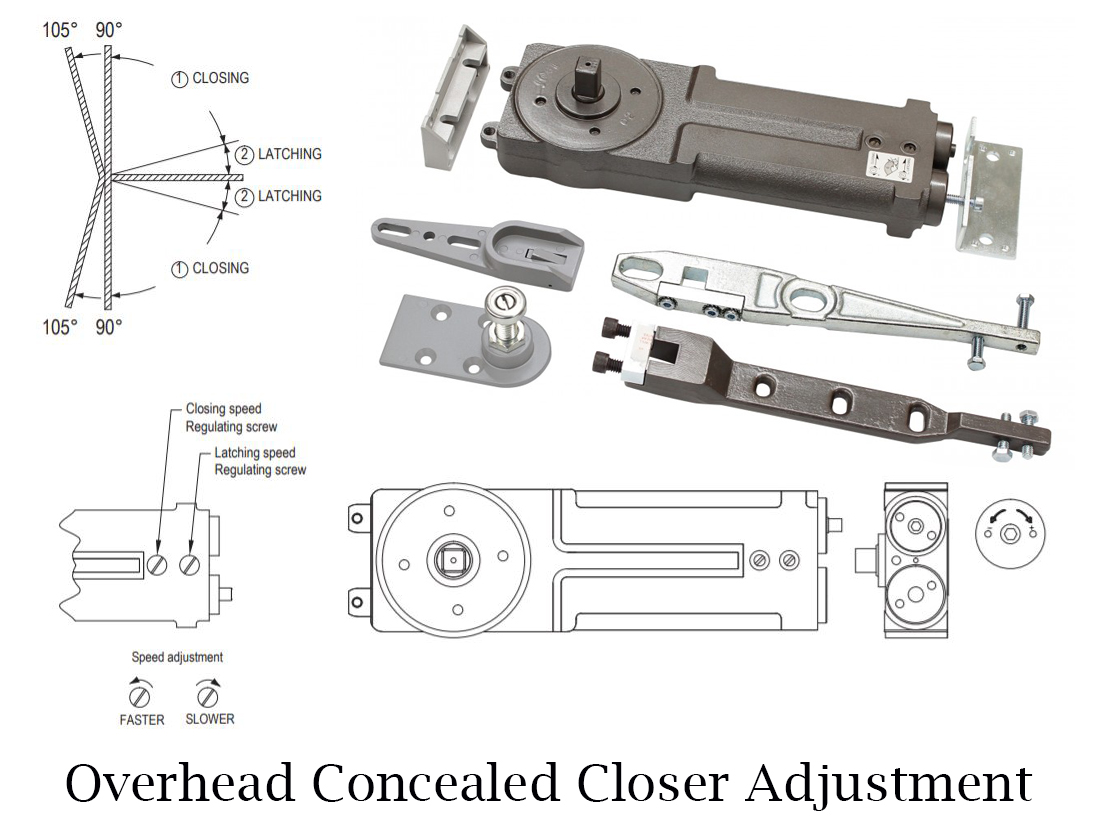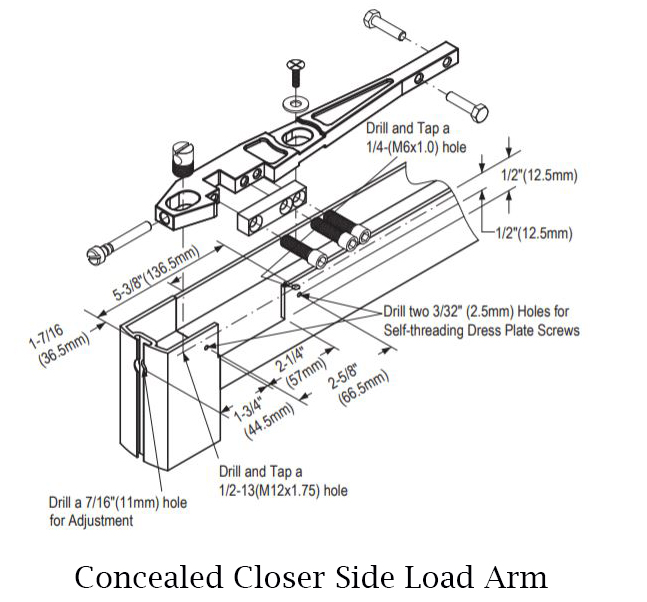![]()
How To Adjust Aluminum Storefront Doors?
Storefront doors are the #1 type of commercial door used for front entry doors into retail stores. As a result, if the storefront door is working properly, it can impede traffic going into the store, hurting the business. In this article, we explain how to diagnose, adjust, and fix aluminum storefront doors.
Aluminum Storefront Door Is Slamming Closed
One of the most common issues is an aluminum storefront door that slams. There could be 2 possible scenarios happening here. Scenario 1 is that the hydraulic door closer on the storefront door simply needs to be adjusted. Scenario 2 is that the hydraulic door closer ruptured it's o-ring seals and is leaking hydraulic fluid. Luckily if the door closer is defective and needs to be replaced, it is very easy to identify as hydraulic fluid would be leaking from the door closer body.
Adjust The Door Closer
Assuming that there is no hydraulic fluid leaking from the door closer, in most situations the door closer would just need to be adjusted. There are 2 types of door closers used in commercial aluminum storefront doors. The most popular type of door closer is the surface door closer.
Surface Door Closer Adjustment
This door closer is either mounted to the top of the door rail, or at the top of the door frame. There are 2 adjustment valves located on the side of the door closer. Please note, if your door closer has a plastic cover, you will need to remove that in order to access the adjustment valves. Typically, the two valves are labeled "S" and "L". Where "S" stands for sweep speed and "L" stands for latch speed. The sweep speed adjustment controls the main speed of the door as it closes from the full open position to approximately 10 degrees of opening. The latch speed adjusts the closing speed for approximately the last 10 degrees before the door is in the full closed position. Generally, the latch speed can be reduced and this will stop the door from slamming closed. Please note, these valves should only be adjusted 1/8 turn at a time. Never fully unscrew the adjustment valve. If unscrewed fully, the valve will be completely open and leak hydraulic fluid. Once the valve is completely unscrewed, the door closer cannot be repaired and a new door closer will have to be purchased.
![]()
Concealed Closer Adjustment
The second type of door closer the storefront door may have is an overhead concealed door closer, also known as a transom door closer. This door closer has a flat skinny shape that allows it to mount directly above the door in the door frame.
![]()
Other than this door closer being mounted within the door frame, it essentially functions just like a surface door closer. When you open the door and look up at the door frame header there will be an aluminum plate with two holes in it exposing the valve adjustment screws. If this plate is removed, you will be able to clearly see the door closer body. On the door closer body the valves typically are labeled "S" and "L" like the surface closer. In some cases it may show a rabbit and a turtle. The rabbit would indicate the main closing speed or sweep speed from the full open position to 10 degrees closed. While the turtle would indicate the latch speed from the last 10 degrees closed to the fully closed position. Again, typically adjusting the latch speed will stop the door from slamming. If any hydraulic fluid drops are seen at the top of the door frame, this would indicate that the concealed door closer is defective and needs to be replaced entirely.
![]()
Leading Edge Of Storefront Door Is Dragging
If the door is center hung, over time the door arm may shift causing the leading edge of the door to sag and drag on the floor. A center hung storefront door is an aluminum door that uses an overhead concealed door closer.
Door Arm Adjustment
The arm of the concealed door closer mounts directly in the center web of the top rail of the door. If the door is swung open, at the top of the door rail you will see the door arm that is screwed into the web of the door. In most cases you can loosen these screws and readjust the door so that it is not sagging. we recommend using a shim underneath the leading edge of the door to make sure it is square and plumb. Then tighten the screws.
Center hung doors either use an end load arm or a side load arm. An end load arm simply refers to how the door closer arm attaches to the spindle, and how it is accessed. With an end load arm the two screws that hold the arm onto the door closer spindle are located at the heel of the door. To access them you would need to open the door to 90 degrees. At the top of the heel side of the door there is a cut out, which allows you to access the door closer arm screws. Make sure each screw is tight. Tighten one screw, then tighten the other. Repeat until both are tight. If these two screws are loose, the door will not be attached securely enough to the door closer spindle and will cause the door to sag.
![]()
Side load arm function the exact same way, except that as you can guess the two screws are accessed on the side of the door. If you look at the top of the door there is typically a manufacturer sticker which hides the two screws. Simply remove the sticker and the two screws will be exposed. They should be tight as well.
![]()
Glass Jack Adjustment
At the top of the storefront door there is also an adjustment screw known as the "glass jack." Adjusting this will instantly raise the sag of the door on the leading edge, however you must be very cautious when adjusting this. As it is screwed in clockwise it pushes down on a special piece of plastic or other type of material which is directly on top of the glass. This plastic piece or other material which the manufacturer uses acts as a buffer between the glass jack screw and the glass. The challenge is most storefront doors that begin to sag are much older. Overtime it is possible the plastic piece that the glass jack comes in contact is missing or has moved. So when you go to screw in the glass jack, the adjustment screw is going directly into glass, and will instantly cause the glass to shatter. Our recommendation is that if you plan to use the glass jack as an adjustment tool, remove the top glass stop on the door and visually verify the proper plastic piece is there so that the glass jack screw is not touching the glass directly.
![]()
Bottom Pivot Adjustment
Most storefront doors use a bottom pivot. A bottom pivot is comprised of two pieces. There is a door shoe which is attached to bottom web of the door. Then there is a bottom pivot pin which is attached to either the bottom door frame or the threshold. The door shoe contains a sealed ball bearing where the bottom pivot pin mates. On the bottom pivot portion which attaches to the jamb or threshold, there is usually a small allen key screw. Loosen this allen key set screw. Then at the base of the bottom pivot, you will see it is hex shaped. With a wrench loosen the bottom pivot pin. This will raise the bottom pivot. Once adjusted to the proper height so that the door is no longer dragging, tighten the allen key screw.
![]()
Storefront Door Not Closing
In some instances, building owners may experience a scenario where their storefront door does not close all the way. This may be as severe as the storefront door stopping half way closed or as subtle as the door just not latching in the full closed position. Here are some quick checks that can be done to get rid of this problem.
Check Weatherstripping
If the aluminum storefront door is not closing, begin looking for obstructions. Most storefront doors have bottom brush door sweeps. These are typically surface mounted to the door and are adjustable. Verify that the door sweep is not causing too much friction on the ground and impeding the door from closing.
![]()
Check Bottom and Top Pivots
The top and bottom pivots use sealed ball bearings in their design. Check to make sure the ball bearings are still good and that they are not defective or broken. You may need to remove the door to check them properly.
![]()
Check The Threshold
Most storefront doors use thresholds. Check that the threshold is properly secured to the ground and the bottom of the door is not rubbing on it.
![]()
Check For Door Sag
As you close the door, look at where the door stops and is not closing. What is the door touching or rubbing against at that point?
Check The Door Closer
If the door appears to be free and clear, the issue may be the concealed door closer or surface door closer. The door closer's internal spring may be broken causing the storefront aluminum door not to close.
Conclusion
Overtime it is not uncommon that aluminum storefront doors need adjustment. In fact, this can be expected, after all storefront aluminum doors are the entry doors to retail stores and are used thousands of times a day. Identifying the cause or source of why the storefront door is not operating properly will lead you into doing the proper adjustment to your storefront door to properly fix it. If you are in need of storefront door replacement hardware shop at Door Closers USA. As a manufacturer of Comanche storefront aluminum doors we know storefront doors and hardware. Shop today and receive FAST, FREE Shipping!
![]()
DISCLAIMER:INFORMATION PROVIDED THROUGH THIS SITE IS PROVIDED TO YOU AS IS WITHOUT ANY EXPRESS REPRESENTATIONS OR WARRANTIES OF ANY KIND, AND WE MAKE NO REPRESENTATION OR WARRANTY THAT THIS SITE (OR ANY INFORMATION PROVIDED IN RESPONSE TO YOUR INQUIRY), WILL BE ACCURATE, COMPLETE, OR ERROR-FREE.YOU AGREE THAT YOU MUST EVALUATE ALL INFORMATION AND RESPONSES, AND THAT YOU BEAR ALL RISKS ASSOCIATED WITH, THE USE OF THIS SITE, INCLUDING ANY RELIANCE ON THE ACCURACY,COMPLETENESS, OR USEFULNESS OF ANY INFORMATION OR MATERIALS MADE AVAILABLE THROUGH THIS SITE.












